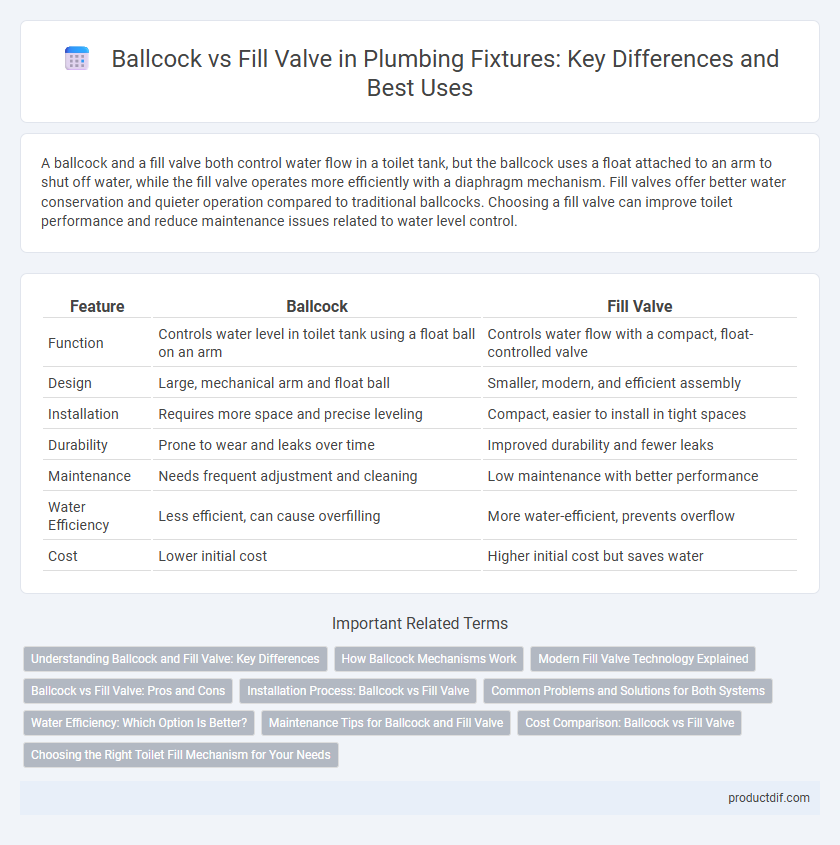A ballcock and a fill valve both control water flow in a toilet tank, but the ballcock uses a float attached to an arm to shut off water, while the fill valve operates more efficiently with a diaphragm mechanism. Fill valves offer better water conservation and quieter operation compared to traditional ballcocks. Choosing a fill valve can improve toilet performance and reduce maintenance issues related to water level control.
Table of Comparison
| Feature | Ballcock | Fill Valve |
|---|---|---|
| Function | Controls water level in toilet tank using a float ball on an arm | Controls water flow with a compact, float-controlled valve |
| Design | Large, mechanical arm and float ball | Smaller, modern, and efficient assembly |
| Installation | Requires more space and precise leveling | Compact, easier to install in tight spaces |
| Durability | Prone to wear and leaks over time | Improved durability and fewer leaks |
| Maintenance | Needs frequent adjustment and cleaning | Low maintenance with better performance |
| Water Efficiency | Less efficient, can cause overfilling | More water-efficient, prevents overflow |
| Cost | Lower initial cost | Higher initial cost but saves water |
Understanding Ballcock and Fill Valve: Key Differences
A ballcock is an older style plumbing fixture that uses a float attached to a lever to regulate water flow into a toilet tank, while a fill valve employs a more compact, adjustable mechanism for refilling the tank. Fill valves are preferred for their improved efficiency, quieter operation, and ease of installation compared to traditional ballcocks. Modern plumbing systems commonly utilize fill valves due to their enhanced water-saving features and better reliability.
How Ballcock Mechanisms Work
Ballcock mechanisms regulate toilet tank water levels by using a float connected to a lever that controls the valve's opening and closing. When the water level drops after a flush, the float lowers, triggering the ballcock to open and allow water to refill the tank. As the water rises, the float lifts, gradually closing the valve to stop water flow once the desired level is reached, ensuring efficient tank refilling.
Modern Fill Valve Technology Explained
Modern fill valve technology in plumbing fixtures offers enhanced water flow control and durability compared to traditional ballcock mechanisms. Fill valves utilize diaphragm or piston-based systems, enabling quieter operation and more precise water level regulation in toilet tanks. These advancements improve efficiency, reduce leaks, and simplify maintenance in residential and commercial plumbing.
Ballcock vs Fill Valve: Pros and Cons
Ballcock valves offer reliable water shutoff with a simple mechanical design, making them durable and easy to repair but prone to slow refilling and potential noise issues. Fill valves provide more efficient and quicker tank refilling with adjustable water levels, reducing water waste and offering quieter operation, though they may require more frequent replacement due to plastic components. Choosing between ballcock and fill valve systems depends on prioritizing durability and repairability versus efficiency and noise reduction in plumbing fixtures.
Installation Process: Ballcock vs Fill Valve
The installation process for a ballcock involves attaching a lever arm and float assembly to the fill tube, requiring proper alignment to regulate water flow effectively. In contrast, a fill valve installation is simpler, typically involving a single unit that connects directly to the water supply line with adjustable height settings. Fill valves often feature quicker assembly steps and fewer moving parts, reducing the likelihood of leaks compared to ballcock installations.
Common Problems and Solutions for Both Systems
Ballcocks and fill valves commonly experience issues such as leaks, slow filling, and continuous running water, often caused by worn seals, debris buildup, or faulty floats. Regular cleaning, replacing rubber washers, and adjusting float arm height effectively restore proper functioning in both systems. Upgrading to modern fill valves can improve reliability and water efficiency compared to traditional ballcock models.
Water Efficiency: Which Option Is Better?
Ballcocks are traditional plumbing fixtures known for their simple mechanism but often result in higher water consumption due to less precise control over tank refill. Fill valves, particularly modern diaphragm or piston types, offer improved water efficiency by regulating refill rates more accurately and reducing wastage. Upgrading to a high-efficiency fill valve can lead to significant water savings and lower utility bills compared to conventional ballcock valves.
Maintenance Tips for Ballcock and Fill Valve
Regular inspection of ballcocks and fill valves helps prevent leaks and maintain optimal water flow in toilets. Cleaning mineral deposits from the valve seat and adjusting the float arm can ensure smooth operation and extend the lifespan of plumbing fixtures. Replacing worn-out washers and seals in ballcocks or fill valves restores proper function and reduces water wastage.
Cost Comparison: Ballcock vs Fill Valve
Ballcock valves generally cost less upfront, ranging from $10 to $25, making them a budget-friendly choice for basic toilet models. Fill valves, priced between $15 and $40, offer greater reliability and efficiency, which can lead to reduced water usage and lower utility bills over time. The initial investment in a fill valve often results in cost savings through enhanced performance and fewer maintenance needs compared to traditional ballcock mechanisms.
Choosing the Right Toilet Fill Mechanism for Your Needs
Ballcock and fill valve are two common types of toilet fill mechanisms that regulate water flow into the tank after flushing. Ballcocks use a float attached to an arm to control water shutoff, offering simplicity but potential for wear and leaks over time, while fill valves utilize a piston or diaphragm for more precise water control, improved efficiency, and quieter operation. Selecting the right mechanism depends on factors like water efficiency, maintenance frequency, and compatibility with your toilet model to ensure optimal performance and longevity.
ballcock vs fill valve Infographic

 productdif.com
productdif.com